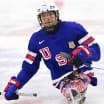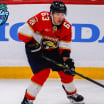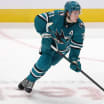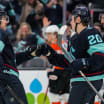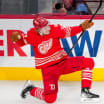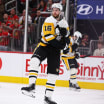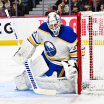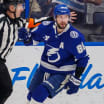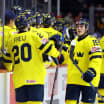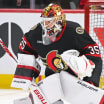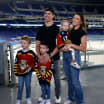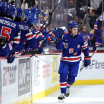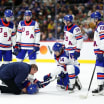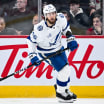How Ovechkin's one-timer became unstoppable on Capitals power play
Owning left circle puts forward on pace to break NHL man-advantage goal record

The Capitals captain already has his stick cocked in the shooting position before defenseman Dmitry Orlov passes him the puck from the center point. Everyone at Capital One Arena knows what's coming, but that doesn't help St. Louis Blues goalie Jake Allen.
The one-timer is off Ovechkin's stick in a flash and past Allen on the short side for the 238th power-play goal of his career, moving him one ahead of Brendan Shanahan for sixth in NHL history.
STL@WSH: Ovechkin one-times PPG to pass Shanahan
Over his 14 NHL seasons, the 33-year-old left wing has made a living scoring on one-timers like that one on Jan. 14.
"I just try to do my best to shoot the puck and we'll see what's going to happen with it," said Ovechkin, who returns to the ice when the Capitals face the Boston Bruins at Capital One Arena on Sunday (12:30 p.m. ET, NBC).
Of course, there's a lot more to it than that. If the goalie doesn't, from countless repetitions, Ovechkin usually has a pretty good idea of where the puck is going.
Like Wayne Gretzky was known for setting up teammates from his office behind the net, Ovechkin has made the left circle his workplace.
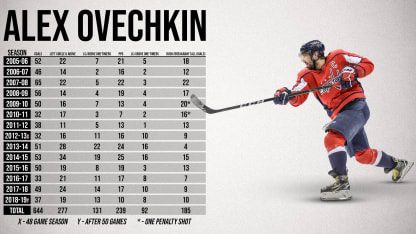
Ever wonder exactly how many goals Ovechkin has scored from there?
NHL.com charted each of Ovechkin's 644 career goals, including a League-leading 37 this season. The numbers aren't surprising.
• 277 goals scored from the left circle or above (43%)
• 131 goals scored on a one-timer from the left circle or above (20.3 %)
• 92 of 239 power-play goals scored on a one-timer from left circle or above (38.5%)
What might surprise some is the jump since the start of the 2012-13 season.
• 161 of 305 goals scored from the left circle and above (52.8%)
• 97 of 305 goals scored on a one-timer from the left circle or above (31.8%)
• 71 of 128 power-play goals scored on a one-timer from the left circle or above (55.5%), including eight of his 10 power-play goals this season.
The reasons for that increase in the second half of his career, particularly on the power play, are explored below as part of an in-depth study of Ovechkin's one-timer. There are other elite goal-scorers, such as Steven Stamkos of the Tampa Bay Lightning and Patrik Laine of the Winnipeg Jets, who are known for their one-timers from the left circle, but teammates, opponents and coaches say Ovechkin's is special.
"Very unique," Capitals goaltender Braden Holtby said. "It's probably the best shot in the history of the game."
In the beginning
The first pick in the 2004 NHL Draft, Ovechkin entered the League in 2005-06 as a superstorm of power, speed and skill. On his way to winning the Calder Trophy as the NHL's top rookie, he scored 18 of his 52 goals on breakaways and rush plays, including a legendary one against the Phoenix Coyotes on Jan. 16, 2006 while sliding on his back in the left circle.
As a right-handed shot, Ovechkin has always preferred playing on his off (left) wing, which gives him more opportunities to use his one-timer. But he didn't score on it often as a rookie.
Of the 22 goals Ovechkin scored from the left circle or above in his first NHL season, seven were on one-timers. And five of his 21 power-play goals that season came on one-timers from the left circle or above.
"He was more of a rush player then," said Glen Hanlon, the Capitals coach during Ovechkin's first three NHL seasons. "He was all over the place. We didn't have him [in the left circle] on the power play. But we didn't have the same personnel as they do now."
Ovechkin remembers initially playing on the half wall and on the goal line on the power play with Andrew Cassels, Jeff Halpern, Dainius Zubrus as the other forwards and defensemen Bryan Muir, Mathieu Biron or Jamie Heward on the point.
"Back then, we didn't have a 100 percent system on the power play of what we're going to do," Ovechkin said. "We'd just go out there and play, like, 'OK, whatever is there, we're going to take it.'"
Muir made the pass from the point on Ovechkin's first NHL power-play goal on a one-timer from the left circle or above. It came on Nov. 6, 2005 against the Toronto Maple Leafs.
Ovechkin's shot from about 10 feet above the left circle deflected off the stick of Toronto defenseman Bryan McCabe in front and went in over goalie Mikael Tellqvist's left shoulder for his 10th goal of the season. Muir had three primary assists on Ovechkin power-play goals like that in 2005-06.
"I remember that play," Muir said. "It was an easy way to get assists when I learned what he could do, and we saw his shot. And he liked to park himself in that spot."
TOR@WSH: Ovechkin one-timer deflects past Tellqvist
The setup
The arrivals of Mike Green, a right-shot defenseman who was the No. 29 pick in the 2004 draft, and Nicklas Backstrom, a left-shooting playmaking center who was the fourth pick in the 2006 NHL Draft, gave the Capitals two more weapons on their power play and opened things up a little for Ovechkin. He scored 22 of his NHL career-high 65 goals in 2007-08 on the power play, but only three of those on one-timers from the left circle or above.
That power-play one-timer remained a smaller part of Ovechkin's repertoire throughout his first seven seasons. And after scoring at least 50 goals in four of his first five seasons, he dropped to 32 with seven power-play goals (two on left circle one-timers) in 2010-11.
CGY@WSH: Ovechkin rips one-timer for power-play goal
Ovechkin increased his goal output to 38 with 13 on the power play in 2011-12, but one of his power-play goals that season was scored on one-timer from the left circle or above. That changed after Adam Oates took over as the Capitals coach in 2012-13.
Oates brought with him the 1-3-1 power play he used with much success as an assistant with Tampa Bay and the New Jersey Devils. That alignment, utilized by most teams now, has a player on the goal line to the right of the net, a playmaker on the right half wall, a shooter in the slot, a defenseman at the point and, of course, a right-handed shot in the left circle for the one-timer.
With the Lightning, Oates had Stamkos as the triggerman for the left circle one-timer. With the Devils, it was Ilya Kovalchuk.
With the Capitals, Oates had what he considered an underutilized weapon in Ovechkin. In their first meeting, Oates asked Ovechkin to move lower in the circle.
His reasoning was simple.
"If you think about it, the farther you get away from the goalie, you have to shoot it five miles an hour harder," Oates said. "So every inch you move away from the goalie, you'd better shoot it harder because the goalie is only rotating a certain distance."
With either Green or John Carlson, another right-hander, at the point and Backstrom on the half wall, the Capitals had two options to feed Ovechkin for the one-timer. But when Ovechkin moved down in the circle, that opened up a third passing option from the player on the goal line.
In 2012-13, Mike Ribeiro was often in that position (now Evgeny Kuznetsov), with Troy Brouwer (now T.J. Oshie) in the slot. That season, the Capitals power play vaulted from 16.7 percent and 18th in the NHL in 2011-12 to 26.8 percent and first in the League
After scoring 21 of his 111 power-play goals (18.9) in his first seven seasons on one-timers from the left circle or above, Ovechkin scored 10 of his League-best 16 power-play goals (62.5 percent) that way in the 48-game lockout-shortened 2012-13 season and led the League with 32 goals total.
Ovechkin led the League again in 2013-14 with 51 goals and 24 power-play goals, including 16 power-play goals on one-timers from the left circle or above (66.7 percent). Washington's power play was second in the NHL that season at 23.4 percent.
"We were just more aware of the positioning for the other side (of the ice)," Backstrom said. "I think that helped Ovi, gave him more space and made it harder for the goalie."
The pass
Although Oates was fired after the Capitals didn't qualify for the Stanley Cup Playoffs in 2013-14, they kept the 1-3-1 power play. They've added a few wrinkles under current coach Todd Reirden, who took over running it after joining them as an assistant under Barry Trotz in 2014-15, but the basic structure is the same.
When the puck goes to Ovechkin for the left circle one-timer, it most often comes from the defenseman at the point, who've accounted for 63 primary assists on 92 goals (68.5 percent). In his 10 seasons with the Capitals, Carlson has 29 of those primary assists, including 15 the past two seasons.
Green, who played 10 seasons with the Capitals before joining the Detroit Red Wings as an unrestricted free agent in 2015, had 22 primary assists on Ovechkin's left-circle power-play one-timers. That includes eight in 2014-15 when Ovechkin scored a career-high 25 power-play goals, 16 on left-circle one-timers.
If the point man doesn't shoot, he has to keep the penalty killer closest to Ovechkin and the goaltender honest by faking a shot or looking them off. That gives Ovechkin a little more space and an extra split second to get his shot off, and the goalie less time to slide over to make the save.
"I think most of the time it's either me reading off the guy that's covering me or the guy that's responsible for [Ovechkin] and his movement and how the defensemen play it are different every day," Carlson said. "Those are things we pre-scout and we try to execute. We still have more guys, so we should be better off more times than not."
Backstrom is usually the one passing to the defenseman at the point, as evidenced by his 34 secondary assists on Ovechkin's power-play one-timer goals from the left circle or above.
But Backstrom also has 12 primary assists on such goals.
Making that pass from the right half wall through the center of the penalty killers' box sometimes involves elevating the puck over the defenders' sticks.
"You've got to get it through," Backstrom said. "Usually there's more sticks involved there in the middle, but sometimes it's open."
The sweet spot
Players taking a one-timer usually prefer the pass at their back foot, so they can take a full slap shot without having to adjust their body position. Elite goal-scorers such as Ovechkin can get off a good one-timer even when the pass isn't to that spot.
"Everything happens so quick, so you don't always have time to accurately pass it," Green said. "He kind of has a wide range to his sweet spot, so you didn't have to be precise with the pass. It kind of just had to be within that range and he would get it off."
Muir remembers Ovechkin's sweet spot being, "back third, from his back foot to two thirds to the middle (between the front foot and back)." After spending four seasons as an assistant with the Pittsburgh Penguins searching for ways to contain Ovechkin's power play one-timer, Reirden talked with Ovechkin when he joined the Capitals in 2014 about widening that shooting zone.
"We felt like he had a sweet spot that was only this big," Reirden said, holding his hands about 18 inches apart. "If we could force it that it was anywhere out of there, then we had a chance if we did give up a shot. We had a thought of pressuring and why we did that at certain times, so he didn't get that puck in that spot.
"That's changed since I've been here because he's worked on it. He's expanded that [sweet spot] two feet both ways [on each side of his back foot]. And his ability to shoot rolling pucks has been something that he's definitely improved."
Ovechkin insists the location of the pass doesn't matter.
"Sometimes the pass is perfect, but you can't shoot the puck," he said. "Sometimes it's a bad pass and you do a good shot."
An example of this came in the Capitals' 4-3 overtime win against the New York Rangers on Oct. 17. Carlson lunged to his left to keep the puck in at the point and flipped a pass to Ovechkin, who was outside the top left quadrant of the circle, that bounced.
Ovechkin one-timed it on a quarter windup and the puck was in the net, inside the far post, before goalie Henrik Lundqvist could react.
"I didn't get set," Lundqvist said. "I was expecting a pass. That was not really his normal spot. I remember that goal. He was further out, and he shoots it usually when he gets set up to shoot. That's when he shoots it."
Oates compared Ovechkin's ability to get off a good one-timer on an errant pass to that of his former Blues linemate Brett Hull, who is fourth in NHL history with 741 goals and also was known for his right-handed one-timer. Oates, a 2012 Hockey Hall of Fame inductee, had 90 assists in 1991 when Hull scored 86 goals -- the third highest single-season total in NHL history.
"With Brett, not every one of my passes was perfect, but boy did he make them look perfect," said Oates, now a skills consultant for the Los Angeles Kings and other top players through his Oates Sports Group. "The good goal-scorers can figure out a way to adjust their body and get shots away that are not perfect passes. Their range within their body of shooting, they get 50 shots that other guys don't get."
The shot
Hanlon remembers Ovechkin incessantly working on his shot early in his career.
"You'd watch him in practice and he was always shooting the puck," Hanlon said. "The whistle would blow when you're trying to get guys toward the boards and Ovi was still firing pucks toward the net."
These days, Ovechkin rarely uncorks a one-timer at full speed in practice. At least not with a goalie in the net.
"Oh, we've had our run-ins in the past," Holtby said, laughing. "I think that's why he doesn't do that too often anymore. I think he realizes how powerful it is and how dangerous it can be when your own teammate is in there."
Opposing goalies don't enjoy it either.
"It's really like a rocket," Columbus Blue Jackets goalie Sergei Bobrovsky said. "It's the perfect height. It's very uncomfortable for the goalie and it comes out so quick and so accurate."
Ovechkin won the PPG NHL Hardest Shot event during the 2018 NHL All-Star Skills Competition with a blast of 101.3 mph and, when he gets all of a one-timer, the goalie sometimes can't stop it even if he's in good position. In that way, Ovechkin's one-timer is similar to that of Montreal Canadiens defenseman Shea Weber, Lundqvist said.
"It's just hard," Lundqvist said. "A lot of his goals are through goalies, like through the arms, through the legs. The power on it is a sign of that because it just squeezes through."
What distinguishes Ovechkin's one-timer from those of Weber, Laine, Stamkos and others is its unpredictability.
"I would say about 85 percent of the time it's a knuckleball," Dallas Stars goalie Ben Bishop said. "When (other) guys shoot it, it goes in somewhat of a straight line. His is dipping, diving, rising, sinking. It just comes at you. It's not like any other shot."
Lundqvist speculated the movement on Ovechkin's shot might be due to the flex of his stick. Ovechkin uses an 80 flex (Weber uses stiffer stick with a 122 flex), which allows him to get more bend on his stick. Oates thought the movement might be from the bigger curve on Ovechkin's stick blade.
Stamkos believes Ovechkin's 6-foot-3, 235-pound frame is a factor.
"In terms of scoring from that side we're similar, but I think if you actually kind of broke down the shot, it's almost completely different in terms of how he uses the flex of his stick and the torque and his weight behind the shot," Stamkos said. "Obviously, I'm a much smaller guy (6-1, 194). For me, it's a little having to pay more attention to technique rather than the flex of the stick or just the weight you can put behind it.
"But I still think his is the toughest to stop in terms of it's hard and it just comes off that stick like a rocket."
Ovechkin initially said he doesn't do anything special to cause the movement, but later acknowledged that there is some method to it.
"How the puck goes: fast, spin, no spin … it depends on the situation," he said.
And, though getting the shot off quickly is the priority, Ovechkin said he is usually able to aim where he wants it to go.
"Yeah, of course," he said. "When you look at where the goalie is, you memorize it and you take a shot in that spot."
Despite Oates trying to move him lower in the circle, Ovechkin has scored 15 power-play goals from above it over the past five seasons. Oates says it's not a high-percentage play, but Ovechkin continues to score from there.
"That's a little bit to do with the movement too," Holtby said. "The farther out, the more it's going to change. And it's the pure power behind it. Not many guys can score from out there, and he's one of the guys that can."
The Ovizoid
While watching the Capitals play the Penguins on television on Jan. 11, 2017, then-Carolina Hurricanes goalie Eddie Lack jokingly suggested on Twitter that the NHL intervene to limit Ovechkin's opportunities for left circle one-timers, as it did to limit where goaltenders can play the puck.
"Trapezoid was invented to slow down (Martin) Brodeur's stick skills," Lack posted about the former Devils goalie. "I say we introduce an Ovizoid to slow down @ovi8!"
Trapezoid was invented to slow down Brodeur's stick skills. I say we introduce an Ovizoid to slow down @ovi8!! 😂🏒🔥 #Ovech1Kin pic.twitter.com/Y4hJlhBnr6
— Eddie Lack🇸🇪🇺🇸🇨🇦 (@eddielack) January 12, 2017
After Ovechkin scored on power-play one-timer from the left circle in the second period, Lack tweeted, "Don't say I didn't warn u … #ovizoidzone."
Lack, currently in the Devils organization, acknowledges now that designating an area Ovechkin where can't shoot probably wouldn't help much.
"Somehow, I feel like they'd move him up and he'd still score," Lack said. "He does it year after year after year."
Fictional and real strategies for containing Ovechkin on the power play produce similar exasperation.
Some wonder why opponents don't have a penalty killer simply stand next to Ovechkin, but teams who have tried that have gotten mixed results.
"It's one of those things where their power play has so many weapons, you can go stand and hug him, but then the other four are going to eat you alive," Detroit Red Wings coach Jeff Blashill said. "So you try to limit the opportunities, you try to limit him from getting it right from that sweet spot."
The Penguins are one of the more aggressive teams at keeping a penalty killer closer to Ovechkin. Pittsburgh forward Bryan Rust, who usually has that assignment, said shadowing was not the accurate term because he has other responsibilities when the puck is on the other side of the zone, but he never strays too far from Ovechkin.
"His shot is so lethal, you have to be within striking distance, be close enough where he can't get that heavy shot off, but also try to kill the rest of the power play, too," Rust said. "It's difficult, but you have to have that ability to kind of read and react when the puck is headed his way."
The Penguins saw in the Stanley Cup Playoffs last season that taking away Ovechkin's one-timer doesn't necessarily shut down the Capitals power play. Although they held Ovechkin without a power-play goal and limited him to one power-play shot on goal in the Eastern Conference Second Round, the Capitals went 4-for-15 (26.7 percent), getting two goals from Carlson and one each from Oshie and Jakub Vrana, and won the series in six games.
"He opens up ice for everybody else," Blue Jackets defenseman Seth Jones said. "Carlson gets a lot of one-timers from the top because teams are worried about Ovechkin. Oshie gets a lot of low shots in the middle because of Ovechkin. That weakside [penalty killer] is not able to help as much as we would like, so you've got to pick and choose."
If the penalty killers lose focus on Ovechkin for a moment, the Capitals only need a small opening to get him the puck.
"That's the challenge," Jones said. "If you're shadowing him in a game and they get three power plays and you do a great job on two of them and he doesn't get a shot, on that third one if you mess up one time for a split second, it's in the back of the net."
What's next?
Through Nov. 19, the Capitals power play was 19-for-64 (29.7 percent) and Ovechkin had scored six of his 15 goals on power-play one-timers from the left circle or above. Since then, he's scored only two power-play goals that way -- at Carolina on Dec. 14 and the one against St. Louis on Jan. 14.
That's a reflection of Washington's power-play struggles the past two months. Since Nov. 19, they are 13-for-83 (15.7 percent). Since Dec. 15, they're 6-for-52 (11.5 percent).
The main issue has been getting clean offensive-zone entries, which has prevented the Capitals power play from getting set up.
"The less we get in the zone, the less time we have for opportunities," Carlson said. "Also, when we do get in the zone, I don't think we've been recovering the puck at a high enough level that we're used to. After shots, on 50-50 pucks, stuff like that, we haven't been as good."
Ovechkin remains confident the power play will come around.
"Everybody has to be on the same page," he said. "Everybody has to do the same things that work, and it will work. It's all about us."
Even with the Capitals' power-play struggles, Ovechkin is three goals from his 10th 40-goal season, which would match Mario Lemieux and Marcel Dionne for second most in NHL history behind only Gretzky with 12.
He's on pace to finish with 60 goals. That would be the second most of his career and make him the first to reach 60 since Stamkos in 2011-12. It would also be his eighth 50-goal season, moving him with one of Gretzky and Mike Bossy for the most in League history.
And with 1,179 points (644 goals, 535 assists), the Moscow native is one away from moving ahead of Sergei Fedorov for most by a Russia-born player.
"It is amazing, but when you're built like that guy is, there's no slowing him down," Stamkos said. "To see what he's been able to do in terms of just pure goal scoring ability … it's very impressive."
If Ovechkin maintains his pace for 16 power-play goals in 2018-19, he'll have 245 at season's end and be on track to break Dave Andreychuk's NHL record of 274 at some point during 2020-21. One-timers from the left circle and above will likely account for about 40 percent of that total.
Usually when a player's number is retired, the number is painted on the ice behind the nets for the ceremony. Whenever that night comes for Ovechkin, Backstrom believes there's a more appropriate place to paint his No. 8.
"They should put it in the left circle," Backstrom said. "That would be pretty cool."
NHL.com Senior Writer Dan Rosen and correspondent Craig Merz contributed to this story.
